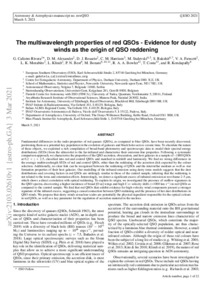The multiwavelength properties of red QSOs: Evidence for dusty winds as the origin of QSO reddening
Rivera G Calistro; Alexander DM; Rosario DJ; Harrison CM; Stalevski M; Rakshit S; Fawcett VA; Morabito LK; Klindt L; Best PN; Bonato M; Bowler RAA; Costa T; Kondapally R
https://urn.fi/URN:NBN:fi-fe2022012811244
Tiivistelmä
Fundamental differences in the radio properties of red quasars (QSOs), as compared to blue QSOs, have been recently discovered, positioning them as a potential key population in the evolution of galaxies and black holes across cosmic time. To elucidate the nature of these objects, we exploited a rich compilation of broad-band photometry and spectroscopic data to model their spectral energy distributions (SEDs) from the ultraviolet to the far-infrared and characterise their emission-line properties. Following a systematic comparison approach, we characterise the properties of the QSO accretion, obscuration, and host galaxies in a sample of ∼1800 QSOs at 0.2 < z < 2.5, classified into red and control QSOs and matched in redshift and luminosity. We find no strong differences in the average multiwavelength SEDs of red and control QSOs, other than the reddening of the accretion disk expected by the colour selection. Additionally, no clear link can be recognised between the reddening of QSOs and the interstellar medium as well as star formation properties of their host galaxies. Our modelling of the infrared emission using dusty torus models suggests that the dust distributions and covering factors in red QSOs are strikingly similar to those of the control sample, inferring that the reddening is not related to the torus and orientation effects. Interestingly, we detect a significant excess of infrared emission at rest-frame 2−5 μm, which shows a direct correlation with optical reddening. To explain its origin, we investigated the presence of outflow signatures in the QSO spectra, discovering a higher incidence of broad [O III] wings and high C IV velocity shifts (> 1000 km s−1) in red QSOs as compared to the control sample. We find that red QSOs that exhibit evidence for high-velocity wind components present a stronger signature of the infrared excess, suggesting a causal connection between QSO reddening and the presence of hot dust distributions in QSO winds. We propose that dusty winds at nuclear scales are potentially the physical ingredient responsible for the optical colours in red QSOs, as well as a key parameter for the regulation of accretion material in the nucleus.
Kokoelmat
- Rinnakkaistallenteet [27094]
